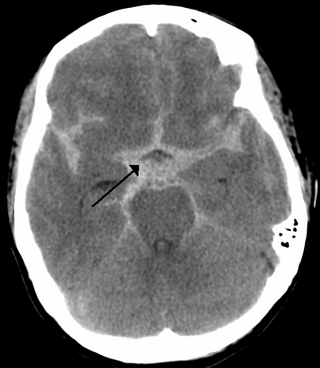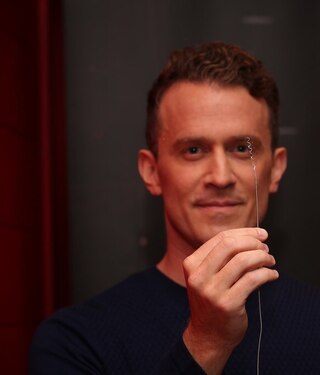
Neurosurgery or neurological surgery, known in common parlance as brain surgery, is the medical specialty that focuses on the surgical treatment or rehabilitation of disorders which affect any portion of the nervous system including the brain, spinal cord, peripheral nervous system, and cerebrovascular system. Neurosurgery as a medical specialty also includes non-surgical management of some neurological conditions.

An intracranial aneurysm, also known as a cerebral aneurysm, is a cerebrovascular disorder characterized by a localized dilation or ballooning of a blood vessel in the brain due to a weakness in the vessel wall. These aneurysms can occur in any part of the brain but are most commonly found in the arteries of the cerebral arterial circle. The risk of rupture varies with the size and location of the aneurysm, with those in the posterior circulation being more prone to rupture.

Vascular surgery is a surgical subspecialty in which vascular diseases involving the arteries, veins, or lymphatic vessels, are managed by medical therapy, minimally-invasive catheter procedures and surgical reconstruction. The specialty evolved from general and cardiovascular surgery where it refined the management of just the vessels, no longer treating the heart or other organs. Modern vascular surgery includes open surgery techniques, endovascular techniques and medical management of vascular diseases - unlike the parent specialities. The vascular surgeon is trained in the diagnosis and management of diseases affecting all parts of the vascular system excluding the coronaries and intracranial vasculature. Vascular surgeons also are called to assist other physicians to carry out surgery near vessels, or to salvage vascular injuries that include hemorrhage control, dissection, occlusion or simply for safe exposure of vascular structures.

Subarachnoid hemorrhage (SAH) is bleeding into the subarachnoid space—the area between the arachnoid membrane and the pia mater surrounding the brain. Symptoms may include a severe headache of rapid onset, vomiting, decreased level of consciousness, fever, weakness, numbness, and sometimes seizures. Neck stiffness or neck pain are also relatively common. In about a quarter of people a small bleed with resolving symptoms occurs within a month of a larger bleed.
Mechanical thrombectomy, or simply thrombectomy, is the removal of a blood clot (thrombus) from a blood vessel, often and especially endovascularly as an interventional radiology procedure called endovascular thrombectomy (EVT). It thus contrasts with thrombolysis by thrombolytic medications, as either alternative or complement thereto. It is commonly performed in the cerebral arteries as treatment to reverse the ischemia in some ischemic strokes. Open vascular surgery versions of thrombectomy also exist. The effectiveness of thrombectomy for strokes was confirmed in several randomised clinical trials conducted at various medical centers throughout the United States, as reported in a seminal multistudy report in 2015.
The International Subarachnoid Aneurysm Trial (ISAT) was a large multicenter prospective randomized clinical medical trial comparing the safety and efficacy of endovascular coil treatment and surgical clipping for the treatment of brain aneurysms. The study began in 1994 with the first results being published in The Lancet in 2002, and the 10-year data were published again in The Lancet in early September 2005. A total of 2,143 study participants were mostly drawn from U.K. hospitals with the rest drawn from North American and European hospitals.

Peter Lin is an American vascular surgeon, medical researcher, specializing in minimally invasive endovascular treatment of vascular disease. He has published extensively in the area of vascular surgery and endovascular surgery.
Joshua B. Bederson is an American neurosurgeon, Leonard I. Malis, MD/Corinne and Joseph Graber Professor of Neurosurgery, and System Chair of Neurosurgery at the Mount Sinai Health System in New York City. He is a Fellow of the American College of Surgeons, and an attending neurosurgeon at The Mount Sinai Hospital.

Robert F. Spetzler is a neurosurgeon and the J.N. Harber Chairman Emeritus of Neurological Surgery and director emeritus of the Barrow Neurological Institute in Phoenix, Arizona. He retired as an active neurosurgeon in July 2017. He is also Professor of Surgery, Section of Neurosurgery, at the University of Arizona College of Medicine in Tucson, Arizona.
Michael Kerin Morgan is an Australian neurosurgeon. Morgan is Emeritus Professor at Macquarie University. Morgan is a retired cerebrovascular surgeon at Macquarie University Hospital, Sydney.

Endovascular coiling is an endovascular treatment for intracranial aneurysms and bleeding throughout the body. The procedure reduces blood circulation to an aneurysm or blood vessel through the implantation of detachable platinum wires, with the clinician inserting one or more into the blood vessel or aneurysm until it is determined that blood flow is no longer occurring within the space. It is one of two main treatments for cerebral aneurysms, the other being surgical clipping.
Y. Pierre Gobin is a French-born American physician who specializes in interventional neuroradiology and endovascular treatment of cerebral aneurysms. He is one of the inventors of the Concentric MERCI Retriever, a device for removing blood clots in the brain that cause stroke.
The Mischer Neuroscience Institute is a combined research and education effort between the Vivian L. Smith Department of Neurosurgery and the Department of Neurology at McGovern Medical School at UTHealth Houston and Memorial Hermann Hospital. Located in Houston, the Institute draws patients from around the world for specialized treatment of diseases of the brain and spine. It was the first center in Texas and one of only a few institutions in the country to fully integrate neurology, neurosurgery, neuroradiology, neuro-oncology, spine surgery, pain medicine and neurorehabilitation.
Interventional neuroradiology (INR) also known as neurointerventional surgery (NIS), endovascular therapy (EVT), endovascular neurosurgery, and interventional neurology is a medical subspecialty of neurosurgery, neuroradiology, intervention radiology and neurology specializing in minimally invasive image-based technologies and procedures used in diagnosis and treatment of diseases of the head, neck, and spine.

Camilo Ramiro Gomez, is an American neurologist, medical educator, and researcher. He is one of the first 100 vascular neurologists certified by the American Board of Psychiatry and Neurology (ABPN). Also, he is one of the founders of the subspecialty of interventional neurology in the United States and one of the first 50 to be certified in this field by the United Council for Neurologic Subspecialties

A flow diverter is an endovascular prosthesis used to treat intracranial aneurysms. It is placed in the aneurysm's parent artery, covering the neck, in order to divert blood flow and determine a progressive thrombosis of the sac. Flow diverting stents consist of structural Cobalt-chrome or Nitinol alloy wires and often a set of radiopaque wires woven together in a flexible braid.

Demetrius Klee Lopes is a cerebrovascular neurosurgeon specializing in neuroendovascular therapy. At Advocate Health, he serves as medical director of the cerebrovascular and neuroendovascular program and is co-director of their stroke program.
Alexander Coon is an American neurosurgeon who is the director of endovascular and cerebrovascular neurosurgery at the Carondelet Neurological Institute of St. Joseph's and St. Mary's Hospitals in Tucson, Arizona. He was previously the director of endovascular neurosurgery at the Johns Hopkins Hospital and an assistant professor of neurosurgery, neurology, and radiology at the Johns Hopkins Hospital. He is known for his work in cerebrovascular and endovascular neurosurgery and his research in neuroendovascular devices and clinical outcomes in the treatment of cerebral aneurysms, subarachnoid hemorrhage, and AVMs.

Thomas J. Oxley is the chief executive officer of Synchron and neurointerventionist at Mount Sinai Hospital in New York City. Trained as a vascular and interventional neurologist, he established the Vascular Bionics laboratory at the University of Melbourne and is currently co-head of this lab. Oxley is best known for founding Synchron, a company building next-generation brain computer interface solutions that has recently announced the first clinical data on a novel stent electrode (Stentrode) neural interface that is inserted through blood vessels. The company was initiated sometime after his cold-call to DARPA for funding, and has received substantial funding from the U.S. Defense Advanced Research Projects Agency (DARPA) and the Australian government to research this minimally-invasive neural interface technology.
Luca Paolo Eugenio Regli is a neurosurgeon and full professor and chairman of the Department of Neurosurgery of the University Hospital of Zürich since October 2012. He is the son of Franco Regli, a Swiss professor of neurology and founder of the Foundation Franco Regli for the Research in the Field of Neurodegenerative Diseases.












